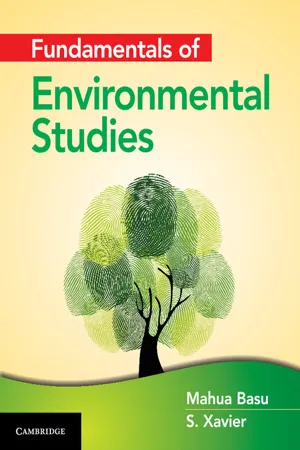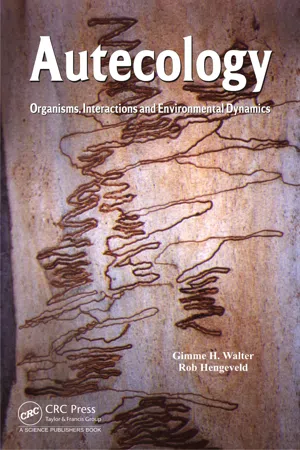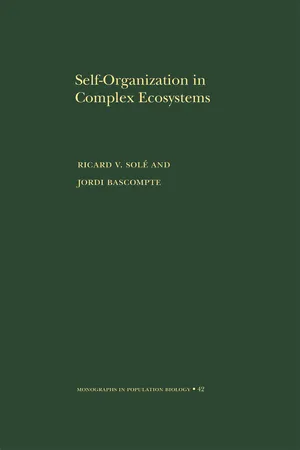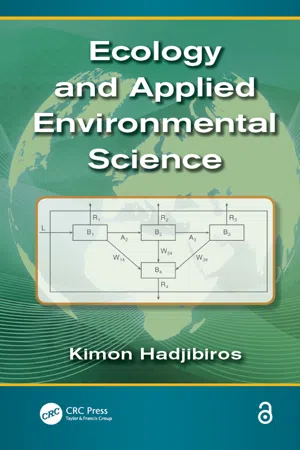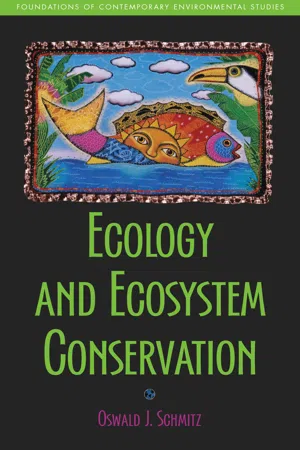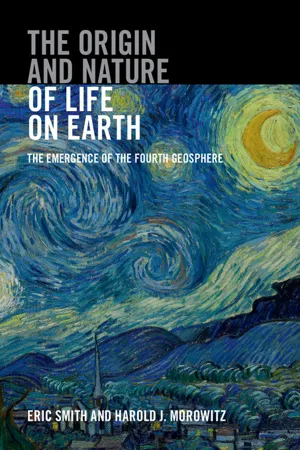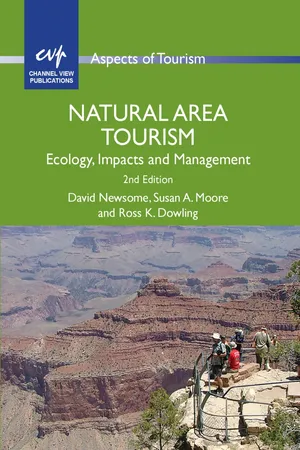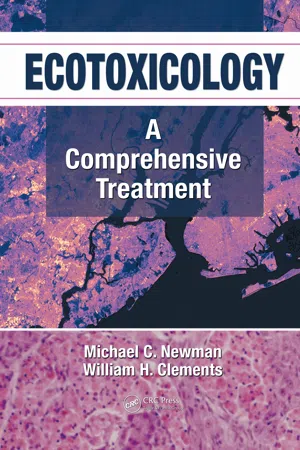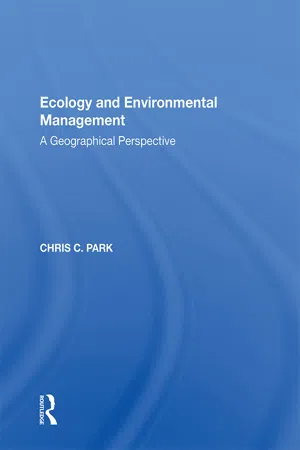Biological Sciences
Ecological Levels
Ecological levels refer to the hierarchical organization of biological systems, from individual organisms to the entire biosphere. These levels include individuals, populations, communities, ecosystems, and the biosphere. Each level represents a different scale of ecological organization and plays a role in understanding the interactions and dynamics of living organisms and their environment.
Written by Perlego with AI-assistance
Related key terms
1 of 5
11 Key excerpts on "Ecological Levels"
- eBook - PDF
- Mahua Basu, Xavier Savarimuthu, SJ(Authors)
- 2017(Publication Date)
- Cambridge University Press(Publisher)
4.1.4 Sub-divisions of ecology There are three levels of integration in ecology – individual; 114 Fundamentals of Environmental Studies population: assemblage of interbreeding organisms belonging to same species inhabiting a given area, for example, Homo sapiens; and community: Group of populations interacting in a given habitat for example, forest floor. Figure 4.1: Levels of organization Molecules Cells Organs Tissues Organisms Communities Ecosystems Biomes Biosphere Earth Solar system Galaxy Universe Populations Atoms Box 4.1: Ecological footprint It may be defined as the impact of the human activities measured in terms of biologically productive land and water that is needed for the production of goods and services and to assimilate the generated waste. It is a measure of natural capital in comparison to Earth’s ecological capacity to rejuvenate. The human ecological footprint was estimated to be 1.5 earth, for the year 2007. Ecological footprint can also be measured for individual countries. 4.2 Concepts of an Ecosystem 4.2.1 Definitions Ecosystems were initially defined as ‘ units of the earth’s surface, i.e., the whole system including the organisms and the physical factors that form the environment .’ (Tansley, 1935) ‘ Ecosystem is a complex in which habitat, plants and animals are considered as one interesting unit, the materials and energy of one passing in and out of the others .’ (Woodbury, 1954) Later on, ecosystems were grouped by their structure and function with much stress on integration and interactions . The ecologists were classified into two groups – those who were engaged with quantifying an ecosystem’s input and output relationships (flows of matter and energy; Evans, 1956) and those that were concerned with particular populations (Levin, 1976). ‘ Populations do react to environmental stimulus and so ecosystems can also be defined by biota and by the environment .’(Chapin et al. , 1997) - eBook - PDF
Autecology
Organisms, Interactions and Environmental Dynamics
- Gimme H. Walter, Rob Hengeveld(Authors)
- 2014(Publication Date)
- CRC Press(Publisher)
In interpreting the workings of individual organisms, biologists frequently refer to various levels of organization, and these range from the molecular, through the biochemical, physiological, and behavioral to the whole organism. However, neither the organism itself, nor the various processes involved actually operate according to different rules within these different “levels”. Nevertheless, 344 Autecology—Organisms, Interactions and Environmental Dynamics these levels of perception are usually represented as levels of organization, with each subsequent level in the hierarchy seen to embody new properties or processes that are not evident at the level below. The processes seen by biologists to operate at the various “levels” outlined above are all parts of one process; the ion channels open (biochemistry), nerve action potentials are generated (physiology), the frog jumps (behavior), it does so for some reason (evolutionary biology), and it may thus survive to reproduce (ecology). This operation, as a whole, allows the organism, as a living system, to function effectively. The categorization into levels of organization is a question of interpretation, and is misleading. These levels simply represent levels of perception. For our own convenience, we impose order on the various ways of asking questions, and we derive molecular, biochemical, physiological, behavioral, evolutionary and ecological answers. The distinction is therefore one of epistemology or method, but we aim at a single ontology or interpretation of the world (Rose 1997). Hierarchies in biology are thus artificial, and are specifiable only in relation to our viewpoint or relative to the types of questions we ask and the scale of resolution of our perceptions and instruments. In ecological systems, therefore, the processes that are significant ecologically exert their influences on the individual organisms, and they do so in combination and simultaneously. - eBook - PDF
- Ricard Solé, Jordi Bascompte(Authors)
- 2012(Publication Date)
- Princeton University Press(Publisher)
At the most fundamental level, single species (or de-scriptors of some of their relevant features) define the smaller scale. Beyond this basic units, we have a level of description in which in-teractions with other species must be considered. At this level, new 5 C O M P L E X I T Y I N E C O L O G I C A L S Y S T E M S F IGURE 1.2. Levels of organization in complex ecosystems. A nested hierarchy of complexity levels can be defined, from single species to biogeographic patterns. Different properties and different problems can be identified at several scales, and some large-scale patterns cannot be reduced to the inferior levels of the hierarchy. phenomena such as population cycles (chapter 2) can only be under-stood after coupling among species has been introduced. Evolutionary paths also need to consider the biotic environment, and some theories of evolutionary ecology, such as the Red Queen hypothesis (chapter 7), emerge as the natural explanatory framework. Under this scenario, new phenomena, such as the appearance of parasites and epidemics have to be taken into account. Beyond this point, the next step in the hierarchy involves the community level, in which the networks of inter-actions between species provide a unifying picture. At the community level, different regularities can be observed suggesting the presence of universal principles of community organization (chapter 6), but histori-cal events implicit in the assembly process have to be taken into account. How external and internal changes propagate through the web of in-teractions among species and affect its stability is one key example of how ecological complexity is influenced by structural properties. At the higher level, the spatial context, the variability associated to local 6 C H A P T E R O N E climate influences, and the global patterns of biotic organization de-fine the top of our hierarchy. - eBook - PDF
Ecology
From Ecosystem to Biosphere
- Christian Leveque(Author)
- 2003(Publication Date)
- CRC Press(Publisher)
Many studies were thus focused on sites or zones judged to be representative of a whole system without considering that biotic and/or abiotic interactions with neighbouring systems were possible. This is what was sometimes called the invisible place, by analogy with the invisible present (Swanson and Sparks, 1990). It is true that the lack of means of large-scale investigation, such as aerial or satellite photography, which are now available, limited the ability of ecologists to spatialize their observations. Spatial analysis has given rise to many studies for redefining organization levels in space by varying the scale of analysis or defining the possible regularities in the spatial structure. Spatial analysis reveals recurrent structures and forms of spatial organization (patterns). It looks for and analyses the processes that are at the source of these structures by means of statistics, modelling, and various other methods. In the history of ecology, there has actually been an epistemological process leading to the identification and definition of basic ecological units characterized by a power of integration that is always larger. To put it more simply, we have passed from the elementary plant association to the biotic community, then the ecosystem, the landscape, and finally the biosphere. In all such transitions, each time we identify a new level of integration, we observe after some time that it is insufficient and that we must refer to a higher level of integration (Bergandi, 1995). 8.2.1. Ecosystems An ecosystem is fundamentally made up of a physicochemical environment called the biotope and a set of living species, animal and plant, called the biocoenosis. This is the basic ecological unit, characterized by its structure andfunctions. At first it was an abstraction rather than a concrete and autonomous entity. Ecologists often speak of the object ecosystem, a discrete and functional unit. - eBook - PDF
- Kimon Hadjibiros(Author)
- 2013(Publication Date)
- CRC Press(Publisher)
15 © 2010 Taylor & Francis Group, LLC Chapter 3 Organisation at Population Level 3.1 POPULATION AND ECOSYSTEM The study of the living elements of an ecosystem could theoretically mean the examination of the actions of all organisms, which are extremely numerous. Therefore, for practical reasons, organisms should be grouped, and individu-als of the same species that live in the same space should be examined as a whole. Thus the concept of population results, which constitutes a basic ecological unit. A significant part of the phenomena observed at a population or ecosystem level can be explained through the interactions of populations. Populations are formed by groups of individuals of the same species that live in a certain place so that they can breed with one another. The total of populations living in one place is called biological community . Important issues concerning population ecology are the prediction of: • Population change over time • Population distribution in space • The abundance of each population within the biological community • The distribution of the individuals of a population by age and sex Population is a characteristic case of a system. Even though population is nothing more than the total of individuals comprising it, it can be described by parameters and variables, such as population size, natality, mortality, immigration, age distribution etc. that have no meaning for each one of the individuals but only for the population itself. These parameters determine in any given moment the state of the population, its temporal change and the manner in which external circumstances affect it. The ecological niche is an important concept of theoretical ecology. It represents the space of a population’s ecological activity, i.e. - eBook - ePub
- Oswald J. Schmitz(Author)
- 2013(Publication Date)
- Island Press(Publisher)
This simple container system is a powerful metaphor for the way species assemble and interact in nature.The processes of production and consumption are fundamental to sustaining the functioning of all ecological systems globally. Natural ecological systems differ from the container system in that they are comprised of vastly more species with many more interdependencies than those found in the glass container. Understanding these complex interdependencies is the fundamental purpose of that subfield of biology known as ecology.What Is Ecology?
Ecology is a science aimed at understanding:- The processes by which living organisms interact with each other and with the physical and chemical components of their surrounding environment.
- The way those processes lead to patterns in the geographical distribution and abundance of different kinds of organisms.
Ecosystems encapsulate many forms of biological diversity (also called biodiversity). Biodiversity results from a variety among individuals comprising a species owing to sex, age, and genetic differences among those individuals. It also stems from differences between species living together in a geographic location. For example, species may differ in their functional roles (e.g., plant, herbivore, carnivore) and the efficiency with which each carries out its function in different environmental conditions. Biodiversity also arises from the myriad ways that species are linked to each other in ecosystems. As a consequence of these many forms of biodiversity, there is considerable complexity underlying the structure of ecosystems.The challenge in ecology is resolving this complexity.Biodiversity results from a variety among individuals comprising a species due to sex, age, and ge- netic differences; from differences between species living together in a geographic location; and from the myriad ways that species are linked to each other in ecosystems. As a consequence of these many forms of biodiversity, there is consider- able complexity underlying the structure of ecosystems. The chal- lenge in ecology is resolving this complexity. - Gabrielle I. Edwards, Cynthia Pfirrmann, Barron's Educational Series(Authors)
- 2021(Publication Date)
- Barrons Educational Services(Publisher)
18ECOLOGY
WHAT YOU WILL LEARN
In this chapter, you will explore the interrelationships among living things and the factors in the nonliving environment that affect life. You will also learn how living things can change the environment.SECTIONS IN THIS CHAPTER•The Concept of the Ecosystem•Energy Flow in an Ecosystem•Biogeochemical Cycles•The Limiting Factor Concept•Greenhouse Effect•Global Warming•Ecological Succession•World Biomes•Humans and the Biosphere•Conservation•Review Exercises•Connecting to Life/Job Skills•Chronology of Famous Names in BiologyOVERVIEW
Ecology is the science that studies the interrelationships between living species and their physical environment. The word ecology was coined in 1869 by the German zoologist Ernst Haeckel to emphasize the importance of the environment in which living things function. The environment includes living or biotic factors and nonliving factors, referred to as abiotic factors.The abiotic factors consist of physical and chemical conditions that affect the ability of a given species to live and reproduce in a particular place. Included in the abiotic factors are temperature, light, water, oxygen, pH (acid-base balance) of soil, type of substrate, and the availability of minerals. Certain kinds of plants and animals will flourish in a natural community if the conditions are present that permit their survival. Species interact to influence the survival of one another. One important principle of ecology is that no living organism is independent of other organisms or of the physical environment, if they share the same community.The Concept of the Ecosystem
Certain terms are used in ecology to provide a consistent description of conditions and events. A population refers to all of the members of a given species that live in a particular location. For example, a beech-maple forest will contain a population of maple trees, a population of beech trees, a population of deer, and populations of other species of plants and animals. All of the plant and animal populations living and interacting in a given environment are known as a community- eBook - PDF
The Origin and Nature of Life on Earth
The Emergence of the Fourth Geosphere
- Eric Smith, Harold J. Morowitz(Authors)
- 2025(Publication Date)
- Cambridge University Press(Publisher)
Thus the ecosystem appears as the bridge between incipient order in geochemistry and the earliest biochemistry. Organisms are a derived level of orga- nization that forms, in diverse ways, within a framework of constraints of biochemical and ecological order that are more conserved than the properties of the individuals that help to instantiate them. Whether we try to understand the nature of metabolic universality, or the widely varying degree of chance and necessity among patterns that together produce the living state, we need a way to refer to ecosystems as primary entities in their own right and as carriers of patterns fundamental to life. Ecosystems must become “first-class citizens” 1 in biology, in some respects prior to and more fundamental than organisms. 2.2.1 No adequate concept of ecosystem identity in current biology Biology in its descriptive tradition, as part of natural history, was sensitive to relations of many kinds, both in the growth and form of organisms and in their ecological rela- tions. Darwin was a master of noticing and cataloging such relations. However, with the publication of On the Origin of Species, Darwin made a commitment to the individual as the sole sufficient level of selection to account for adaptation. 2 The effects of ecological 1 We borrow the title of this section from a famous expression in computer science – Functions as first-class citizens – coined by Christopher Strachey in the mid-1960s [105]. First-class functions are not merely sequences of steps, but genuine entities, which can be passed as arguments to and from other functions in the same manner as other data types [10]. Languages that support this concept have a fundamentally greater expressive power than those that relegate functions to the status of “second-class citizens” relative to first-class “data” objects. - eBook - ePub
Natural Area Tourism
Ecology, Impacts and Management
- David Newsome, Susan A. Moore, Ross K. Dowling(Authors)
- 2012(Publication Date)
- Channel View Publications(Publisher)
Ecology is concerned with the structure and functioning of ecosystems and thus how plants and animals interact together and with the physical environment. Although most ecosystems are very complex and difficult to study as entire systems, their essential structure and function are well established.Ecosystems comprise structural components such as living organisms (biotic components), soil and landforms and other non-living features (abiotic components), such as wind, rain and water flow. Energy and materials, such as water and nutrients, flow through this combined system, resulting in ecosystem function (Figure 2.2 ).The structure of ecosystems
Ecology can be studied from the perspective of populations or communities of plants and animals or whole ecosystems (Figure 2.1 ). A population refers to the number of organisms of the same species which inhabit a defined area, while a community consists of a group of populations of different species interacting with one another in a defined area. An ecosystem, on the other hand, represents a community of organisms interacting with the environment.The scale at which an ecosystem can be identified ranges from the microbial community inside the gut of a cow through to a pond, ocean, forest or the entire planet. Despite this issue of scale, we can conveniently separate ecosystems into the two major divisions of terrestrial and aquatic (Table 2.1 ). These can then be sub-divided further according to the occurrence of specific plant and animal communities and the differing physical factors that determine their existence. On land, for example, differences in moisture and temperature give rise to different ecosystems in the form of forest, woodlands, grasslands and deserts. These comprise the major terrestrial ‘biomes’, which can be further divided according to specific conditions of precipitation, temperature, the occurrence of fire and differences in soil conditions. An example of this can be seen in the global occurrence of forests, which can be divided into tropical rainforests, tropical seasonal forests, temperate rainforests, temperate forests and northern coniferous forest, or taiga. Despite such differences in detail it is possible to define the structure of any ecosystem according to its major biotic (living) and abiotic (non-living) components (Figure 2.2 - eBook - PDF
Ecotoxicology
A Comprehensive Treatment
- Michael C. Newman, William H. Clements(Authors)
- 2007(Publication Date)
- CRC Press(Publisher)
1 The Hierarchical Science of Ecotoxicology I have argued that there is intrinsically only one class of explanation. It traverses the scales of space, time, and complexity to unite the disparate facts of the disciplines by consilience, the perception of a seamless web of cause and effect. (E.O. Wilson 1998) 1.1 AN OVERARCHING CONTEXT OF HIERARCHICAL ECOTOXICOLOGY 1.1.1 G ENERAL Ecotoxicology is the science of contaminants in the biosphere and their effects on constituents of the biosphere, including humans (Newman and Unger 2003). The scope of ecotoxicology is so necessarily encompassing that an ecotoxicologist can study fate or effect of toxicants from the molecular to the biospheric scales. Consequently, it is necessary at the onset to give the context and philosophical vantage from which ecotoxicology will be explored here. That is the goal of this brief chapter. In the opening quote of this section, Wilson articulates a central theme of this book, that is, to explore in detail one level of biological organization at a time with a progressive linking of facts and paradigms among levels. Putting this goal in terms of conceptual systems theory, the complementary processes of differentiation and integration will be addressed. Differentiation is the pulling together of a large number of diverse facts and concepts, while maintaining discrimination among these facts and concepts (Karlins 1973). The book tries to bring the reader’s capacity for differentiation beyond that provided in most introductory textbooks. It also has the sister goal of integration, the gradual interrelating of concepts and information from different levels of biological organization into a coherent whole. These twin goals allow in-depth exploration of paradigms and important approaches at each level while emphasizing as much as possible the complementary nature of information extracted from proximate levels. - eBook - ePub
- Roger Park(Author)
- 2019(Publication Date)
- Routledge(Publisher)
Table 3.18 ) related to both the structure and function of the organic world is integrated within the ecosystem approach. Colinvaux has suggested that 'the ecosystem concept is one of the most powerful ideas of ecology, a concept which allows us to examine the workings of the natural world in an objective and understanding way' (Colinvaux, 1976); whilst Caldwell concludes that 'no more promising means for relating the biological and social science contributions to an understanding of human life in its environmental context has yet been found' (Caldwell, 1966). Because it offers such a unifying framework within which to consider both biotic and abiotic aspects of environmental management, Ripley and Buechner (1967) refer to the ecosystem as a point of synthesis of the 'human-society-plus-environment complex'.Table 3.18 MAIN PROPERTIES OF THE STRUCTURE AND FUNCTION OF ECOSYSTEMSECOSYSTEM STRUCTURE: (a) composition of the biological community (such as species numbers, biomass and life history) (b) quantity and distribution of abiotic materials (such as nutrients and water) (c) range or gradient of conditions of existence (such as temperature or light) ECOSYSTEM FUNCTION: (a) range of energy flow through the system (ECO-ENERGETICS). (b) rate of nutrient cycling (ECO-CYCLING). (c) regulation by physical environment and by organisms (ECO-REGULATION) Source: Odum (1968)Fundamental ecological unit
The ecosystem also appears to be a more meaningful unit on which to base strategies of environmental management than the community, whose virtues have been pointed out by Moss and Morgan (1967). Evans (1956) argues that the ecosystem is the basic unit of ecology for four main reasons. The ecosystem involves the movement and accumulation of matter and energy through the medium of living things and their activities; and the system is characterized by a large number of regulatory mechanisms which limit the numbers of organisms present, influence their physiology and behaviour and control the qualities and rates of movement of matter and energy. The concept of ecosystems applies at all levels from individual plants to the entire biosphere; and ecosystems are, by definition, open systems rather than closed ones.Systems analysis and modelling
A further value of ecosystems is that techniques of systems analysis can be readily applied (Chorley and Kennedy, 1971). In particular mathematical modelling of system behaviour and response can be valuable in characterizing system changes in response to either internal or external stresses, and in predicting the likely ecosystem changes associated with human manipulation or exploitation. Halfon (1976) has demonstrated that modelling techniques can give valuable results, but he also warns that much study now needs to be devoted to objective methods of modelling, and in particular to solving operational problems of systems identification and optimal solutions for systems aggregation procedures. Modelling can be valuable in predicting the impacts of management strategies. For example Botkin, Janck and Wallis (1972) have outlined a dynamic computer model of forest growth in which future changes in the state of a forest can be predicted on the basis of the present state of the system plus random future changes. The model has been calibrated for the Hubbard Brook ecosystem, and it simulates the end process of competition between species and between individuals, of secondary succession (see Chapter 4
Index pages curate the most relevant extracts from our library of academic textbooks. They’ve been created using an in-house natural language model (NLM), each adding context and meaning to key research topics.
